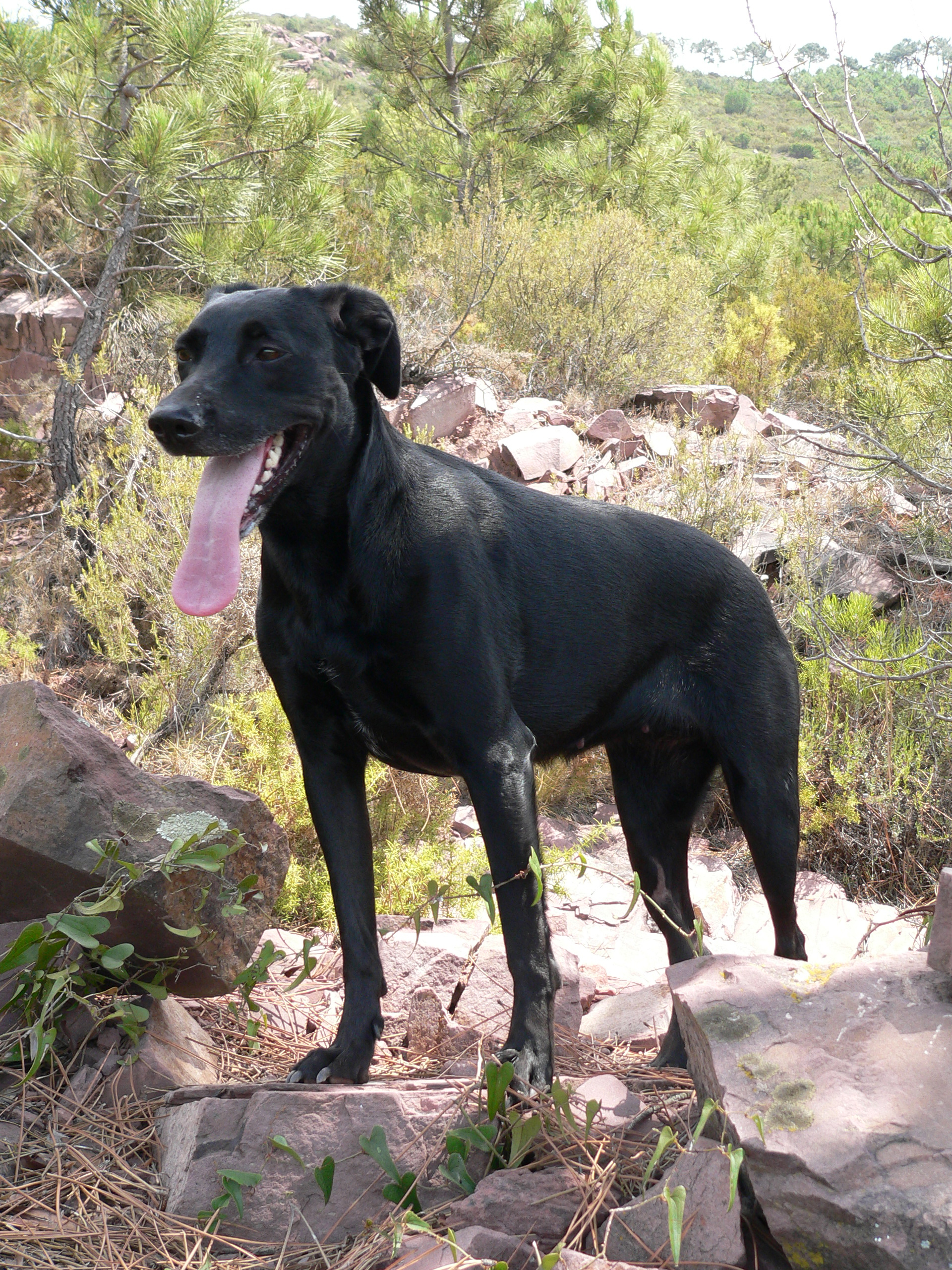Also known as the Ca de Bestiar Mallorca, Perro de Pastor Mallorquin, Mallorquin Shepherd, and Majorca Shepherd Dog. This breed first caught my attention after I purchased a copy of Dr. Bruce Fogle's The New Encyclopedia of the Dog. They look rather remarkably like black field-bred Labrador Retrievers, but they are indeed exceptionally different when it comes to behavior.
The breed is Spanish in origin, coming from the Balearic Islands. It is a herding and guardian breed, and was bred for function rather than looks. The ancestry is of unknown dogs from the European mainland. They are black in color, but do quite well in hot climates. They are bold, tenacious, independent dogs and are described as "uncomplicated, unsophisticated, and utilitarian." Their popularity has been spreading to other parts of the world, including South America where it is used as a guardian dog. There is also some effort to used it to protect sheep ranches from coyotes in North America.
It is accepted by the FCI and UKC, though the FCI standard is currently unavailable in English. According to the UKC, the breed is characterized as follows:
Height: 22-24 inches
Weight: 77-88 pounds
Coat: short
Color: black
Overall, the standard appears to be a very loose.
Here's a video of one of these dogs herding. I can't get over how much they look like my Ebon.
Image is copyright free from Wikimedia Commons.


I think one of these Iberian retriever-like herding dogs is in the background of the retrievers. The Portuguese and the Spanish Basques fished the Grand Banks for centuries, and these dogs would have been great guards. I think they bred with the Iberian and English water dogs and curs to form the St. John's water dog.
ReplyDeleteCol. Hawker is the earliest source for "Labrador" dogs, and he mentions them as great fighters. The old texts also talk about how brindle markings were the sign of a dog being of pure Labrador extraction.
I think the word Labrador is a misunderstanding of the Portuguese word Laboreiro, which points to a dog very similar to the Ca de Bestiar, the Cao de Castro Laboreiro. It looks like a brindle Lab-- and what's more, they come in yellow, too.
The big genomic studies that have looked at dog and wolf ancestry have shown that the retrievers and the Newfoundland are close relatives, but their closest relatives are dogs like Rottweilers and Bernese mountain dogs-- not spaniels and setters. Those would also be relatives of these "Iberian cur" breeds.
So I think there is something to this.
Although somewhat sleeker, I was amazed how similar is this picture of a majorca shepherd
Deletehttps://www.viarural.com.ar/viarural.com.ar/ganaderia/mascotas/fotografias-perros/pastor-mallorquin-08.jpg
To this St John's water dog picture in your blog.
https://retrieverman.files.wordpress.com/2009/05/st-johns-water-dog-small-ears.jpg?w=500
This is very intriguing. History can sometimes be a bit muddy, and since there really isn't much known about this breed's ancestry I do wonder what sort of dogs went into its making. As for its connection to the Labrador, I do wonder where all of the various dogs brought over from Europe came from. For all we know, there could very well be a dog or two from these islands or perhaps the same sort of stock (possibly the Cao de Castro Laboreiro) could have been used, at least in part, for both.
ReplyDeleteBrindle is still seen in the Labrador breed today. When a puppy shows up that is black and tan or chocolate and tan it will often have brindle striping.
Brindle is still found in Chesapeakes, too.
ReplyDeletehttp://retrieverman.files.wordpress.com/2011/04/brindle-chesapeake-bay-retriever1.jpg (Look closely. It's hard to see).
I also know some golden retriever/malinois crosses that were brindle. Goldens have brindle, but it's masked by the e/e.
http://www.goldmali.co.uk/maligold1.html
(Warning: Bad music.)
The golden who fathered the litter was a Yeo, which were an elite line of goldens that were bred my Lucille Sawtell. She passed away a few years ago, but her dogs are in lots of different show and performance lines of golden retriever.
So there are likely lots of "cryptic brindles" in golden retrievers.
I've seen the "maligolds" before. I think I might have found them through your backlogs.
ReplyDeleteIt is always interesting to see what a dog is hiding under recessive red. It makes me wonder how often a golden mix comes out brindle. From the looks of that litter, it looks as though some of the "black" dogs could be heavily shaded sables, so I'm suspicious the father might have been heterozygous for brindle. It does make me curious as to how common the gene is.
We have a ca de bestiar and she is the most wonderful sensitive dog! We love her dearly. She was a rescue doggy from majorca and now lives with us in berlin.
ReplyDeleteShes very streetwise as you would expect but has none of the guarding tendencies they often purport to have. Sheis however very bonded to us and shy of other people but not dogs